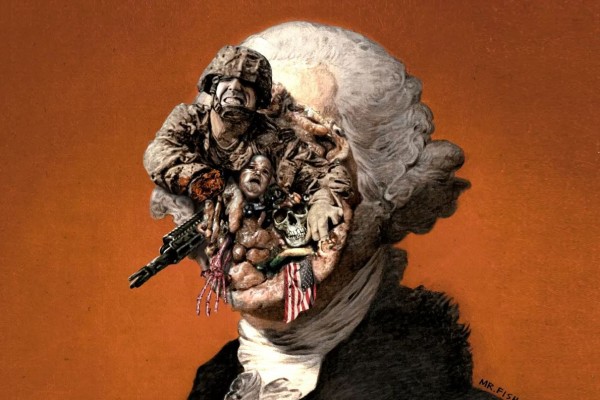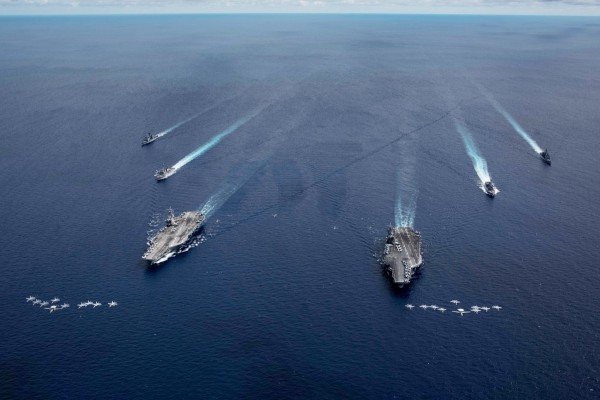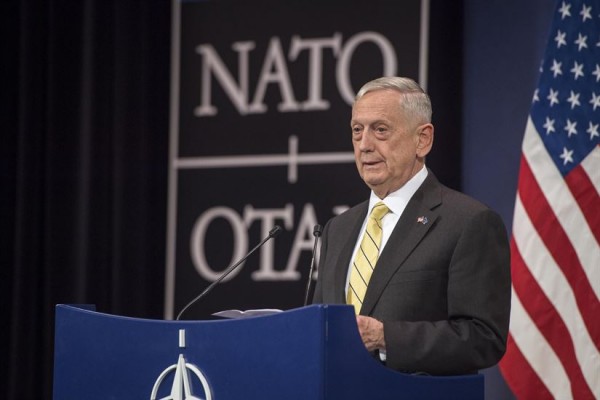A Fly’s Eye View of America’s War Against Vietnam, Part Two
In the Ointment

Photo by James K. F. Dung
In 1966, the US anthropologist Jules Henry wrote in The Nation:
The establishment throughout Southeast Asia of industrial complexes backed by American capital is sure to have a salutary effect on the development of our foreign involvement: the vast land’s cheap labour pool will permit competition with the lower production costs of Chinese and Japanese industry, which have immobilized our trading capabilities in Asia for many years… The destruction of the Vietnamese countryside is the first, and necessary step, to the industrialization of Vietnam and the nationalization of its agriculture.
Henry’s assessment of US Asia-Pacific policy was quite controversial at the time, certainly not because it was peculiar but because it was open. Social science in the West has occasionally been critical but most of its practitioners, seated in well-endowed universities and research institutions, were wittingly and unwittingly complicit in the collection and analysis of data to advance corporate penetration of markets, both at home and abroad. Social scientists were first employed on a large scale in the US during the so-called “Progressive Era”. They replaced or augmented the work previously done by missionaries in the colonies. That is to say they were on one hand part of the informal intelligence apparatus supplying the data about indigenous cultures and social structures then used by colonial authorities to penetrate local communities either to turn them in favour of the invading forces or to make administrative and military measures against them more effective.
In the US itself, social science became a weapon against organised labour and other popular movements. Together with the “professionalization” of journalism, social sciences transformed the discourse of popular resistance to capitalism into specialised, institutional knowledge reserved for academically certified “experts”. This was the primary mission of the so-called liberal philanthropic foundations founded at the beginning of the 20th century; e.g., Rockefeller, Sage, Carnegie, and especially the Ford Foundation. Pulitzer’s funding of the first journalism school at the University of Missouri was a crucial step in killing partisan newspapers and creating today’s propaganda cadre whose claim to public legitimacy was then based on “objectivity”—a euphemism for corporate censorship. At the same time by offering lucrative employment and career opportunities to writers and activists, these foundations made it possible for the peculiar form of “intellectual freedom” to evolve in the US without the need to ban publications or imprison literate dissenters. Intellectual freedom became synonymous with whatever the “market” would tolerate—whatever corporations could sell. Undesirable dissent simply did not sell—or better said would not be sold. Paid professional writers and scholars acquired a vested interest in protecting their exclusive access to employment and publication. In the higher ranks of academia the “peer review” process served to enforce consensus by rewarding scholars for imposing self-censorship to assure continued funding and wider censorship in order to protect the resulting privileges. Just as Taylorism was promoted to enforce infinitesimal divisions of labour in what had been highly skilled crafts, corporate-supported specialisation reduced academic research to an ever-expanding class of cottage industries with little or no relationship to each other or to the popular movements that had previously published the dirt on capitalism and imperialism needed to guide their members.
Henry’s point-blank analysis of the strategic and tactical operations of Capital was certainly a source of embarrassment to those who were determined to keep imperialism cloaked in philanthropic garb. Yet his honest statement of the US regime’s objectives in Southeast Asia (already a firm component in US Latin America policy) merely rendered a specific formulation of the “primitive accumulation” Marx described in Das Kapital. Marx explained in detail the importance of the Tudor confiscation of the monasteries during the Reformation and the Enclosures that began in 16th century England and intensified between 1760 and 1820. This policy had two primary objectives: a) creation of surplus population and b) the confiscation of land for capitalist exploitation of agriculture and sub-surface resources. British industrialisation depended upon forcing subsistence farmers off their land in order to create an additional supply of virtually free labour and initially an increase in the production of wool for its textile mills. When India was conquered by the “first multinational”, the British East India Company, the manual textile industry there was systematically destroyed to increase the competitiveness of Britain’s nascent textile industry and turn India into a market for British cotton manufactures. Part of the surplus population was also used to invade the two continents “discovered” in the 15th century where the massive amounts of new gold and silver helped finance even more European development. The new money enabled Europeans to buy their way into Asia and, together with the opium trade started by the Company, to reverse the chronic balance of payments deficit with China. The new wealth sucked out of the Americas, mainly captive slave labour stolen from Africa, eventually allowed European empires to subsidise a slightly better standard of living in the metropolitan countries facilitating social control.
These “stages of development” were certainly not unique in human history. Until the 15th century it would appear that the prevailing world power, China, had reached a dominant position in Asia by exporting its own population throughout Asia, establishing systems of trade and political domination not unlike those created by the inhabitants of the European peninsula.
Perhaps it is also fair to make at least a structural comparison between the power of China and its “overseas Chinese” and the Anglo-American empire with its multi-national corporations. If we allow this hypothesis, then it may be possible to articulate a theory of war, commerce and empire with some explanatory value in describing the fate of subordinate peoples throughout the world and the contradictory processes that seem to frustrate the projects and processes of human liberation. No doubt considerable understanding of human history—at least in the past millennium—has been obtained by analysing events distinctly as social, political, military and economic processes. Yet this separation, especially as it became professionalised, of human activity into distinct and separate forms of interaction also prevents any coherent examination of human society as a whole. Due to the consequences of this intellectual development, human social relations have been systematically degraded.
It is no accident that the most sophisticated and differentiated social formations—states—are almost universally genocidal when it comes to the treatment of the “countryside”—especially so-called indigenous peoples who are then relegated to the status of “primitive”—another euphemism meaning worthless or non-persons. The creation of states and their progeny, the multinational corporations, has exhibited what may be called nihilistic tendencies. These can be seen best in the continual destruction which accompanies supposed creativity and stabilisation.
Therein lies one of the central contradictions in both imperial crusades and wars of national liberation. In other words, if we take the finite nature of the planet seriously and with it the fact that humans are ultimately terrestrial (as opposed to aquatic or aerial) creatures, the basic struggle can be reduced to how any given portion of the human species establishes its ability to survive on the finite amount of land the planet offers. With the exception of the insignificant quantity of landfill concentrated in coastal and riverine regions, the amount of habitable land has not changed much in the course of human history. The allocation for occupation and exploitation of that land constitutes the underlying dispute at the core of all “advanced” political organisations. Yet this central issue remains one of the most obfuscated. This source of conflict in everyday life within so-called developed countries is obscured both by the high level of urbanisation and the subsequent derivative forms of land occupation and use found there. Suppression of this issue is one of the primary goals—if not the ultimate goal of political warfare.
The legitimacy of any claim to control of land, whether individually or collectively asserted, is still—all industrialisation and digitalisation notwithstanding—the political aim of all social, economic, military or religious violence. Politics in this context means the organisation of the means to legitimate, enforce and exploit the claim to land—abstracted as territory and endowed with metaphysical attributes from which the claimant asserts sovereignty. The title of Thomas More’s classic Utopia bears a certain irony in that the word means “nowhere”. One might argue that the search for an irrefutable claim to political order can only end in “nowhere”, in the denial of human habitation as a local and natural given, no different from that ascribed to flowers or even birds.
In 1953, US President Eisenhower told a conference of state governors:
Now, let us assume that we lost Indochina… the tin and tungsten that we so greatly value from that area would cease coming… So when the United States votes 400 million dollars to help that war, we are not voting a give-away program. We are voting for the cheapest way that we can to prevent the occurrence of something that would be of most terrible significance for the United States of America, our security, our power and ability to get certain things we need from the riches of the Indonesian territory and from Southeast Asia.
The wars in Indochina, concentrated in Vietnam, can be understood as wars over the control of land. However, that too is an oversimplification. In fact, the major complaint of the European and American forces, and those who led them, was that they often never felt able to control the land. Instead they were barely able to occupy it, albeit briefly, and destroy its utility for the indigenous inhabitants.
Unlike the North American continent, Indochina seemed to resist every means to which the US military was accustomed in the seizure of territory. The simplest explanation for this is that the forces of the United States no longer sought—for reasons the explanation of which would exceed the scope of this essay—to replace the native inhabitants with its own population imported as surplus from the US itself. The US ruling elite did not seek (and arguably could not have achieved) a resettlement on the scale necessary to become a dominant presence in Indochina, let alone Asia.
By 1965, Henry Cabot Lodge—who was then Kennedy’s ambassador to South Vietnam—was quoted in the Boston Globe:
Geographically, Vietnam stands at the hub of a vast area of the world—Southeast Asia—an area with a population of 249 million persons. He who holds or has influence in Vietnam can affect the future of the Philippines and Formosa to the east, Thailand and Burma with their huge rice surpluses to the west, and Malaysia and Burma with their rubber, ore, and tin in the south… Vietnam does not exist in a geological vacuum—from it large storehouses of wealth and population can be influenced and undermined.
Gabriel Kolko distinguishes the initial US war aims:
… to quickly redress many of the post-war global dilemmas and frustrations of its military power, to confirm its symbolic credibility and the technical efficiency of its arms. The goal was to neutralize the rising potential throughout the Third World for revolutionary nationalist regimes…. The primary origin of the Vietnam War was the American intervention and effort to establish and sustain an alternative to the Communist Party, and Washington assumed there was a sufficient indigenous basis to give it increasing hope for success.
He goes on to argue that US foreign policy after WWII aimed “to create an integrated capitalist world framework out of the chaos of World War II and the remnants of the colonial systems… because it sought a controllable, responsive order elsewhere, one that would permit the political destinies of distant places to evolve in a manner beneficial to American goals and interests far surpassing the immediate interests of its domestic society.” However, as Philip Agee so poignantly argued, capitalism cannot survive without the repressive apparatus of its “invisible army”.
Kolko’s staid formulations are like many that can be found throughout political science scholarship. How, then, are such objectives to be judged? What do these statements tell us about the kind of violence organised and unleashed against the Third World? Why should the US regime—given the admittedly vast ignorance of its military and foreign policy establishment regarding Indochina—have had any reason to believe that it could determine the nature of legal and accepted political organisations in Vietnam? To come to a reasonable understanding of what the US regime’s aims in the war were, it is essential to know who sets those “American goals and interests”? Why should the US population unscarred by war since 1865 be motivated to fight and die as well as submit to privation for the reasons Kolko enumerates? Moreover why were the war aims for the military ostensibly framed in conventional war doctrine—as if this were a war between Germany and France over Alsace—while the real war was fought in accordance with completely different principles? The answer to this question is not made any easier by noting that the US was (and still is) waging war throughout the world—making Vietnam only one theatre of operations.
The US war aims—at least in the terms comprehended by its own military institutions—could not have been achieved by any amount of armed force applied. While this may seem obvious, especially in retrospect, the discrepancy between US military capability and the real as well as perceived success of US forces in Indochina ought to raise the question what the real war aims were and what is the proper understanding of strategic and tactical operations in Indochina between 1946 and 1975. A brief consideration of some “highlights” might help. Here it is important to pay attention as much to what is said as what is omitted, to the assumptions upon which self-deception fundamentally relies.
CBS News correspondent Morley Safer established the company’s Saigon bureau in 1965. Shortly thereafter he was witness to a “search and destroy” mission conducted by US Marines in the village of Cam Ne, near Da Nang. His field dispatch became famous as he showed US Marines entering a village with no opposition and subsequently destroying it. His film was broadcast into US living rooms showing marines torching thatched cottages with Zippo lighters and flamethrowers, leaving the entire village homeless and destitute. An apparently astonished Safer can be seen looking into the camera while the marines are at work. The report caused an outrage, especially in William Paley’s ultraconservative (mainstream) corporate headquarters. In reflecting on the report later David Halberstam added that this was certainly an uncommon and surprising scene because Americans had been brought up to think of “Indians”* burning villages and the US military coming to the rescue—while here is was the US military torching the huts.
A U.S. Marine from 1st Battalion, 3rd Marines, moves a supposed NLF activist to the rear during a search and clear operation held by the battalion 15 miles (24 km) west of Da Nang Air Base • Photo by U.S. Marine Corps/PFC G. Durbin
Safer then submitted a report on the Battle of Ia Drang. The dispatch was broadcast as a CBS News Special Report, introduced by Walter Cronkite and followed by Safer’s description of the event with the film. Safer explains that the US Army 1st Air Cavalry regiment was being sent to raise the siege against a Special Forces camp in Plei Mi, located in the central highlands near the Laotian border. The viewer is not told what Special Forces (Green Berets) do or why the Vietnamese might want to destroy the camp. The story continues more or less modelled on the reporting everyone has been taught in the newsreels. At the end of the story the US Army wins: the Army takes a hill that had been held by Vietnamese troops. The settlers have been saved from the Indians.
Thirty years later, he recounted the incident with the same bewilderment to an audience meeting at the State Department to discuss the American experience in Southeast Asia. He recalled how much trouble he had gotten because of this naïve report. The vicarious shock was magnified by the doubts inserted as to whether this was premeditated arson or merely an extreme reaction to an invisible enemy.
Thus a report of what was essentially criminal activity by US troops was coated with dishonesty. By suggesting that the US Marines had assumed the role usually associated by Americans with the Indians he was, in fact, providing the subliminal rationale for the unacknowledged counter-terror campaign, which had been, and was to remain, the foundation of US military operations throughout the war.
Actually it was the US Army that had historically attacked Indians, burning their homes and destroying their means of subsistence—if they were not killed outright. The burning settler homes enshrined in the penultimate US film and literary genres were misrepresentations of the ultimately futile Indian resistance to invasion of their lands and destruction of everything they needed to survive.
Morley Safer and others were shocked to the extent that they could not point to any white settlers that the marines or air cavalry had to defend. The story of the non-human communists in Vietnam, who were actually Vietnamese but could never be called that, had to be repeated daily and nightly in order for this ostensibly occasional violence to be rationalised as some kind of self-defence.
The war waged by the US in Vietnam had to be framed in terms of territorial defence. The vast incoherence between the territorial defence rationale for US conventional warfare—actually the pretence of conventional warfare—lies in the fact that aside from the War of 1812, which it nearly lost to the British, the US has never had to defend its territory from a foreign invader. The overall deceit underlying the war against Vietnam was not the concealment of military tactics but the cultivation of the perverse set of fears among US Americans manipulated according to the country’s most primitive but historically well-anchored founding myths and fantasies.
Even the landing of marines at Da Nang was not so much a military necessity as a narrative device to touch the hearts of the home front with imagined memories of the D-Day landing during the “good war”. The purportedly most televised war in US history (at that time) would have made little sense to US viewers had they not been force fed Hollywood/War Department war films and newsreels for decades. Without the thousands of miles of Westerns exhibited as mass entertainment, the “Indian” analogy would have been accessible to relatively few viewers.
Moreover without television and cinema there would probably have been little support for the war at all. Eisenhower had been forced to end the Korean War not only because of Chinese intervention to help the North Koreans repel “UN” Forces but also by potential domestic disruption as what would be called the civil rights movement escalated. In fact, although the US corporate state has been voracious in its appetite for foreign wars, it has always taken enormous amount of propaganda and compulsion to persuade the majority of US Americans to fight abroad. At the same time, however, the massive violence and displays of overwhelming fire power was certainly not embarrassing to those in the US who had been bred to believe in the virtue of American might and invincibility—real or imagined.
The public perception of the war was not only shaped by the reporting during the war but by the approximately two million US Americans who went to Vietnam in the course of the war. Some 55,000 of them died there. In contrast, 405,399 died in all combat theatres during World War II (1941-1945) and 36,516 died in the US war against Korea (1950-1953). Although this figure is modest in comparison to the number of Vietnamese dead, conservatively estimated at between 1.5 and 3.8 million (Korean deaths are also estimated at approximately 3 million), It was the perceived magnitude of US deaths that had the greatest, if not the only, decisive impact on American consciousness. What might be called “Post-Vietnam Stress Syndrome” triggers either bouts of self-pity or vindictiveness, sometimes both, in the US. American deaths were not only the major public issue for those opposing the war, while it was being waged; they fuel the retroactive appreciation of the war against Vietnam.
The war against Vietnam might be considered the first major war the US fought with a non-segregated military. However the rank and file were disproportionately black and poor. Perhaps it is also no coincidence that segregation ended in the US military once the enemy was no longer mainly “white”. The white command structure no longer had to fear unleashing black soldiers on white womanhood since Asians were not considered “white” within the meaning of the act. They too were only “gooks”. The de-segregated military was by no means purged of racism. Nor could it suppress the racism in its greatest reservoir of white cannon fodder—the South. Returning soldiers rarely had noble and heroic tales to share (if that was ever a significant part of war memory). There is no way to measure the real damage done to the bodies and souls of draftees for whom professional killer had not been the occupation of first choice. Since the war ended ignominiously, the largely working class, poor and non-white veterans, had to accept at the same time having fought for nothing.
There were also those whose perceptions of the war triggered opposition: to the war, to the military or even to the government itself.
And yet the war perceived had very little to do with the war that was actually fought, even for those who had been there, been in Vietnam (or elsewhere in Indochina unofficially). Allowing for the distortions in memory over time, it is remarkable how few participant-observers have been able to present a coherent image of the war in which they fought. Frequently statements are made like, “we always won, even if we don’t know what”. The PBS documentary Vietnam: A Television History seems quite typical at least of the film record. Not a single one of the ordinary soldiers interviewed was able to conclude from his experience what the war’s aims were and whether they were even being achieved at the operational level, let alone at the command level. Even allowing for problems of interviewing methodology, the PBS series presented witness testimony at all levels, from ordinary soldiers to cabinet members. Nevertheless the viewer comes no closer to understanding the war as a whole since the story is told in the same way it was told during the war itself. The films and extracts available today in the Internet rely on essentially the same footage, occasionally with different editing.
Another problem, reflecting the real prosecution of the war, is the inconsistent, inaccurate or one might think deceptive designation of the participants interviewed. To give a few examples in the PBS production: John Negroponte is identified as a delegate to the Paris peace negotiations. This is accurate to the extent that the only statements used in the film were his descriptions of negotiations with the DRV in Paris. At the same time this obscures the extent to which he was involved in actually waging the war. Negroponte and his colleague Richard Holbrooke (who was not interviewed in the film) were both active participants in the rural pacification program—an element of Phoenix. Negroponte went from rural pacification where he reported operations in II Corps, the military region of central Vietnam, to be the director for Vietnam of the National Security Council.
Another example is the interview with William Colby. He was identified as the head of the Phoenix Program. The viewer might know that he later became director of the CIA. On one hand the US American Colby is identified as head of Phoenix while on the other hand the film says: Phoenix was run by the South Vietnamese with the help of US “advisors”. In fact, William Colby was the CIA station chief who is considered to be largely responsible for the creation of Phoenix out of a program called ICEX, Colby does not say what Phoenix was in the film—only what it supposedly was not. The only descriptions of what Phoenix might have implied are left to Jane Barton, identified as a civilian aid worker. This is also confusing because although Ms Barton is described elsewhere (Internet) as an employee of the American Friends Service Committee, another person Everett Bumgartner is interviewed in the film, also identified as a civilian aid worker, Bumgartner was William Colby’s deputy in the pacification (Phoenix) program and definitely CIA.
The PBS film is a typical example of how an essential part of US strategy and tactics is presented as no more than a sideshow. Thus the focus on apparently conventional warfare is magnified to produce sustained confusion about the war and inadequate analysis at the same time. Today it is very difficult to draw any sensible conclusions about the war in Vietnam because there is almost no discussion about the war that was actually fought. The narrative of American foreign policy and military strategy is still determined on the official level by the myths of World War II. Any attempt to penetrate that screen which hides the unstated policies, strategy and tactics of the US regime ought to begin with the simply question of who specifically wants to control what exactly? Ultimately there are only two objects of war: land and people. However, humans have shown repeatedly through the centuries—they actually have little control over land itself—no one can live without it. So the central question becomes in reality: Who controls what people and how?
To show just how easily this issue can be actively concealed one can return to Morley Safer. At the American Experience conference he told the following story about a meeting with William Colby who had just assumed his post in Saigon. Colby’s office called Safer and asked him to come meet the next day:
(Colby said) “Look, can you disappear for three days?” (Laughter.) And I said, “I guess.” (Laughter.) And he said, “Well, be at the airport – be at (inaudible) at the airport tomorrow morning at 5:30.
No, no. And I showed up and he said, “Okay, here are the rules. You can see that I’m going on a tour of all the stations. You can’t take notes and you can’t report anything you hear.” And I spent three days – made – first of all, down in the delta and they were really, really revealing. There was only one meeting that he would ask me to leave the barracks. And it was fascinating because the stuff that these guys were reporting through whatever filters to you had been so doctored by the time it got to you – I mean, to this day, I still feel constrained in terms of talking about.
As Telford Taylor once said to me, he said, “Once you know a secret – one you swear to keep a secret, you keep it to the grave.” Well, I keep most secrets to the grave but – and I so I don’t want to go into detail, but – and I’ve often wondered what his motivation was, being a sceptic, why is he doing this, what’s the real story. And to this day, I don’t know unless he was – wanted an uncommitted witness, some – I just don’t know.
Marvin Kalb responded in a manner that ought to seem bizarre now.
Well, at least Colby did it with you for three days. Think about McChrystal inviting a reporter from the Rolling Stone in for a month.
Of course, the remark is bizarre because Safer is still alive.
Without knowing who the people are who are initiating, managing and conducting what are always called merely “operations”, it is impossible to draw any informed conclusions about the relationships between these people, the institutions they represent and the interests vested in those institutions—the progenitors of the war against Vietnam and the wars for the control of land and population that have continued since.
This article originally appeared on DissidentVoice.org.









_600_400_90_s_c1.jpg)
